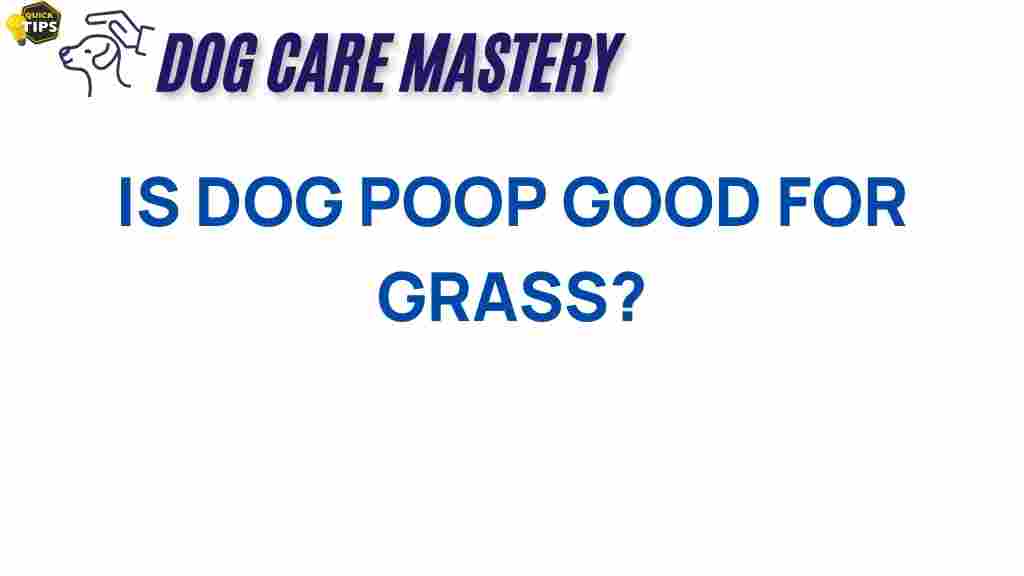Is Dog Poop the Secret to Lush Green Grass?
When it comes to maintaining a healthy and vibrant lawn, many homeowners are always on the lookout for effective fertilizers and gardening techniques. But what if we told you that one of the most overlooked resources for achieving lush green grass is something that many people view as a nuisance? Yes, we’re talking about dog poop. This article will explore the various benefits of using dog poop as a natural fertilizer, how to do it correctly, and some troubleshooting tips to ensure your lawn thrives.
Understanding Dog Poop as a Nutrient Source
Dog poop, often dismissed as waste, is rich in nutrients that can help nourish your lawn. Here’s why it’s beneficial:
- Rich in Nitrogen: Dog poop contains a high concentration of nitrogen, an essential nutrient for plant growth. Nitrogen promotes lush, green foliage and increases overall plant health.
- Organic Matter: The organic matter in dog poop aids in improving soil structure and moisture retention, which is crucial for healthy grass growth.
- Cost-Effective: Utilizing dog poop as fertilizer can save you money on commercial fertilizers while making use of a readily available resource.
How to Use Dog Poop for Your Lawn
Using dog poop in your garden or lawn requires a careful approach to ensure it benefits plants without causing harm. Follow these steps for effective application:
Step 1: Collect the Dog Poop
The first step is to collect the dog poop from your yard. Ensure to wear gloves and use a scoop or bag to avoid direct contact.
Step 2: Composting Dog Poop
Composting is vital to transform dog poop into a safe fertilizer. Here’s how to do it:
- Choose a Compost Bin: Select a bin that’s well-aerated and designed for composting pet waste.
- Add Carbon-Rich Materials: Mix dog poop with carbon-rich materials like leaves, straw, or sawdust to balance the nitrogen content.
- Maintain Temperature: Ensure the compost pile reaches at least 140°F (60°C) to kill pathogens and parasites.
- Turn the Pile: Aerate the compost by turning it every few weeks to promote decomposition.
- Wait for Completion: Allow the compost to mature for at least six months before using it on your lawn.
Step 3: Applying Dog Poop Compost
Once your compost is ready, here’s how to apply it:
- Test Your Soil: Before application, consider testing your soil to ensure it requires additional nutrients.
- Spread Evenly: Use a rake to spread a thin layer of compost over your lawn, focusing on areas that appear sparse or weak.
- Watering: Water the lawn lightly after application to help the nutrients penetrate the soil.
Potential Risks and Considerations
While dog poop can be beneficial, there are some risks and precautions to consider:
- Pathogens and Parasites: Dog poop can contain harmful bacteria and parasites. Composting it thoroughly helps mitigate these risks.
- Over-Fertilization: Excessive use of dog poop can lead to nutrient imbalances in the soil. Always use it in moderation.
- Allergies: Some people may be allergic to certain components in dog poop. Always handle it carefully.
Troubleshooting Common Issues
If you encounter problems while using dog poop as fertilizer, here are some troubleshooting tips:
Issue 1: Foul Odor
If your compost emits a strong odor, it may be too wet or not aerated enough. To resolve this:
- Add more carbon-rich materials to balance the nitrogen.
- Turn the compost more frequently to increase aeration.
Issue 2: Slow Decomposition
Slow decomposition can be frustrating but can be improved by:
- Ensuring the compost pile has enough heat, moisture, and aeration.
- Chopping up larger pieces of dog poop to speed up the process.
Issue 3: Grass Burn
If you notice brown spots or burned areas in your lawn, it could be due to excess nitrogen. To remedy this:
- Reduce the amount of dog poop compost applied to the lawn.
- Water the affected areas more frequently to dilute the nitrogen.
Conclusion
In conclusion, dog poop can indeed be a secret weapon in your quest for a lush green lawn. By harnessing the nutrients found in this readily available resource, you can create a vibrant and healthy outdoor space. Remember to compost it properly, apply it in moderation, and take precautions to mitigate any potential risks. With the right approach, your lawn can flourish with the help of dog poop—making it a win-win situation for both you and your furry friend.
For more tips on natural gardening techniques, check out our gardening blog. And for additional information on maintaining a healthy lawn, visit the Lawn Institute.
This article is in the category Nutrition and created by dogcaremastery Team
